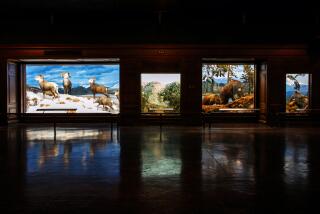Museum renovation makes life better where it’s wetter
- Share via
NEW YORK — A year or two ago, when you entered the old Hall of Ocean Life at the American Museum of Natural History, it was like walking into a huge black box. Now, it’s like swimming under the sea.
Undulating blue lights shine down from the skylight. Speakers produce whale song as dark shadows mimic a whale passing overhead.
But that is just the start of the techno-wizardry in the rechristened Irma and Paul Milstein Family Hall of Ocean Life, newly reopened after being closed for almost a year and a half for a $25-million renovation.
Two new “tree of life” walls include interactive computer stations where visitors can learn more about evolutionary links. Large screens feature high-definition underwater images, including polar seas and kelp forests.
An almost 70-year-old diorama of the Andros coral reef in the Bahamas now has fiber-optic lights highlighting caverns and crevices. And a feature called the “Ocean Wall” -- an 18-foot-by-8-foot video screen -- uses animation to explain how the oceans were formed.
It’s all quite a change from the old hall, where one curator noted that fish were mounted on lollipop sticks.
But it is in line with renovations the 134-year-old museum has undertaken in the last decade -- including its fossil halls, the Rose Center for Earth and Space, and the Hall of Biodiversity, featuring a 2,500-square-foot installation representing an African rain forest.
Other natural history museums nationwide are doing the same -- enhancing traditional displays of artifacts and specimens with videos, interactive displays and hands-on features.
Bonnie VanDorn, the executive director of the Association of Science-Technology Centers, said the new technologies give museum visitors different ways to learn.
“Visitors might prefer to get their questions answered in a variety of ways, from talking to a museum staff person directly, to posing a question at a computer station, to seeking an explanatory video with closed captions or assisted listening devices,” she said.
The Field Museum in Chicago is renovating two permanent exhibits, with plans to add interactive features to both, said Francie Muraski-Stotz, the museum’s manager of exhibition development.
In the Native American halls, plans are underway to develop a tabletop interactive display in which a visitor would play the role of an early hunter and gatherer, making choices that affect the landscape. And in the evolution exhibit, visitors standing in front of a dinosaur model would be able to touch casts of fossils of other animals and plants, causing them to appear on a computer screen as the dinosaur might have seen them.
“I think the technology is best when it really gets people to look at the things in the hall -- the dioramas, the specimens, the artifacts -- and think about how they lived or what the things were used for,” Muraski-Stotz said.
“We don’t want to lose the awe and mystery of the old display techniques, but we also want to bring in new ones that can reach broader audiences and different learning styles.”
Ellen Futter, president of the American Museum of Natural History, said curators there periodically examine permanent exhibits to determine whether they need renovation -- either to update the scientific knowledge or the presentation and quality.
In the Hall of Ocean Life, both aspects needed to be addressed, she said.
“We needed to really tell a more up-to-date story on marine ecosystems and the environment and the extraordinary role of oceans as the cradle of life and the source of most living things on terra firma,” Futter said.
Several beloved features in the Hall of Ocean Life stayed but with some important renovations.
One is the 94-foot-long model of a blue whale, an icon at the museum since 1969. The whale got a more svelte tail, less bulging eyes and a brand new navel, all based on discoveries about blue whales since the original model was installed.
The other is the natural history museum’s trademark dioramas -- a collection of animal and plant specimens arranged against a landscape simulating their native habitat.
Visitors can still see real-size models of diving dolphins or giant walruses sunning themselves on rocks.
But now, schools of tuna, flying fish and seabirds have been added to the dolphin diorama, showing the interdependence of life in the ocean. A fact panel explains why tuna fishing boats are hazardous to dolphins, and a touchable model of a dolphin flipper shows a skeletal structure similar to those in human arms.
The idea for dioramas was developed almost 100 years ago, replacing stuffed specimens in glass cases. Futter said it’s a technique that still fits perfectly into the gleaming new Hall of Ocean Life. “We think of the dioramas as the first forays into virtual reality,” she said.
More to Read
Sign up for The Wild
We’ll help you find the best places to hike, bike and run, as well as the perfect silent spots for meditation and yoga.
You may occasionally receive promotional content from the Los Angeles Times.






